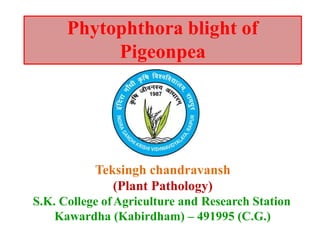
Phytophthora Blight of Pigeonpea-1.pptx
- 1. Phytophthora blight of Pigeonpea Teksingh chandravansh (Plant Pathology) S.K. College ofAgriculture and Research Station Kawardha (Kabirdham) – 491995 (C.G.)
- 2. Phytophthora blight of Pigeonpea • Phytophthora blight of Pigeonpea incited by Phytophthora drechsleri f. sp. Cajani. • It was first reported in 1966 from India and is currently considered to be more important in short‐duration pigeonpeas than in traditional medium‐ and long‐duration types. • It is a potentially important disease of Pigeonpea after fusarium wilt and Pigeonpea sterility mosaic disease. • It is reoccurring as an economically important disease in area where excessive rains fall within a short span of time and hot and humid weather persists during the crop season.
- 3. • It is a major production constraint to pigeonpea in India that kills young plants. • However, it is the most important production constraint in north-eastern India. • The disease occurs throughout India. • The disease has also been reported from other countries. • Yield losses of 5-10% has been reported from this disease
- 4. SYMPTOMS • The pathogen affects the crop at any growth stage under environmental conditions suitable for disease development. • Symptoms appear on the primary and trifoliate leaves as brown to black lesions which subsequently become necrotic within 3 days. • The leaflet lesions are circular to irregular and up to 1 cm diameter. • The whole foliage can exhibit a blighted appearance under conditions of high humidity. • Phytophthora blight resembles damping off disease as the seedlings die suddenly.
- 5. • On stems and petioles, brown to dark brown lesions are formed near ground level. • Stem lesions initially have a flat surface but later become sunken. • They enlarge in size and girdle the stem. • In some cases girdling of the stem is noticed even 1 to 1.5 m up the stem. • The lesions on stem and branches increase rapidly. • Portion of the plant above the lesion are dry out but remain but remains attached to the plants.
- 6. • Later main stems or branches are breaks up easily at this point of infection by wind. • Infected leaves lose turgidity, and become desiccated. • Stems swollen at ground level are also common. • It subsequently develops into cankerous structures at the edges of the lesions, and sometimes lesion areas crack and shred. • Stem lesions are often centre on a leaf scar or site of branch in each initiation and extend direction from the apparent invasion point.
- 7. • As the disease progresses, patches of diseased plants become conspicuous in the field which are visible even from a distance. • When conditions are favourable, infected plants many die. • The roots of Phytophthora blight-infected plants remain healthy.
- 8. PATHOGEN • It is caused by Phytophthora drechsleri f.sp. cajani. • Mycelium coenocytic, hyphal swellings. • Sporangiophores are usually narrow but sometimes widen just below the sporangium. • Sporangia vary in shape from broadly obpyriform to elongated obpyriform, ovoid to elongate. They are nonpapillate and persistent on the stalk. • Antheridia are amphigynous; oogonia have tapered bases and are 22 to 53 µm in diameter. • Oospores are plerotic and 17 to 50 µm in diameter.
- 9. Disease cycle • The disease is soil borne. • The fungus survives as dormant mycelium in soil and in infected plant debris. • Sporangia are formed on phyphae and released zoospores. • These zoospores are act as primary source of inoculum and which are dispersed by wind over short distances during rains. • Zoospores germinate by germ tube and caused infection on the surface of the plants. • Develop the symptoms and produce sporangia. • Sporangia germinate either directly or by production of zoospores. • Sporangia and zoospores are disseminated by the wind. • Sporangia and zoospores act as a secondary inoculum which causes secondary infection on the plants.
- 10. Epidemiology • Soils with poor drainage • The disease incidence was relatively higher in Alfisols than Vertisols. • Deficiency of potassium (K), high doses of nitrogen (N) increased disease incidence. • Low lying areas • Heavy rain. • Temperature 28-30o C. • Cloudy weather and drizzling rain and temperature of 28-300C and leaf wetness of 8hrs favorable for disease development. • Warm and humid weather following infection results in rapid disease development. • Relative humidity 75-96% is coupled with 300 mm rain fall within a week
- 11. Management Cultural control: • Use of pathogen-free seed, • Adopt the crop rotation with non-host crops like bajra, sorghum etc. • Maintain adequate field drainage. • Select fields with no previous record of blight. • Avoid sowing pigeonpea in fields with low-lying patches that are prone to water-logging. • Sow pigeonpea on ridges and provide good drainage. • Use wide inter-row spacing, crop rotation and intercropping with short legumes. • Use potassium fertilizers. • Avoid sowing red-gram in fields with low-lying patches that are prone to water logging. • Deep ploughing in Summer
- 12. Varietal Management: • Cultivars KPL 96053, ICPL 99044, ICPL 99044, 99055, 99099, 93179, BDN 627, Sehore 197, Sehore 197-1, ICPL 187-1, ICPL 84052, ICPL 84023 and ICPL 88009, Hy 4, ICPL-150, ICPL-288, ICPL-304, KPBR 80- 1-4, KPBR 8-2-1 were found resistant against disease. Biological Control • Seed treatments with T. viride or T. hamatum or B. subtilis @ 10g per kg seed. Chemical control: • Seed treatment with 4 g metalaxyl MZ or mancozeb + metalaxyl or captan, thiram or carbendazim per kg of seed . • Foliar spray with metalaxyl or mancozeb + metalaxyl @ 0.3% at weekly intervals.